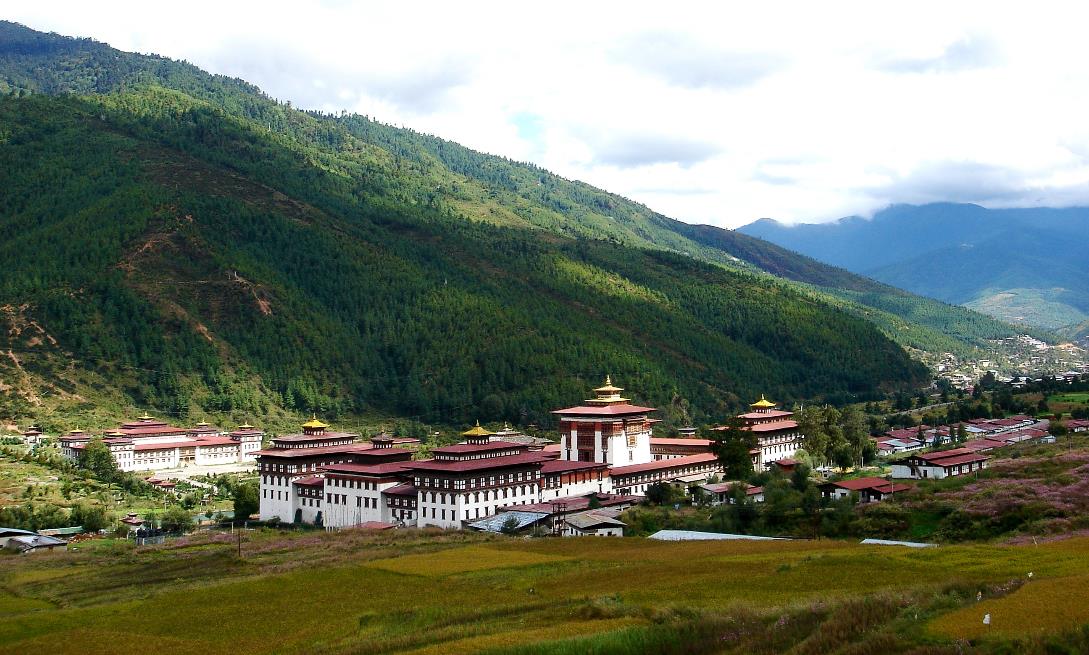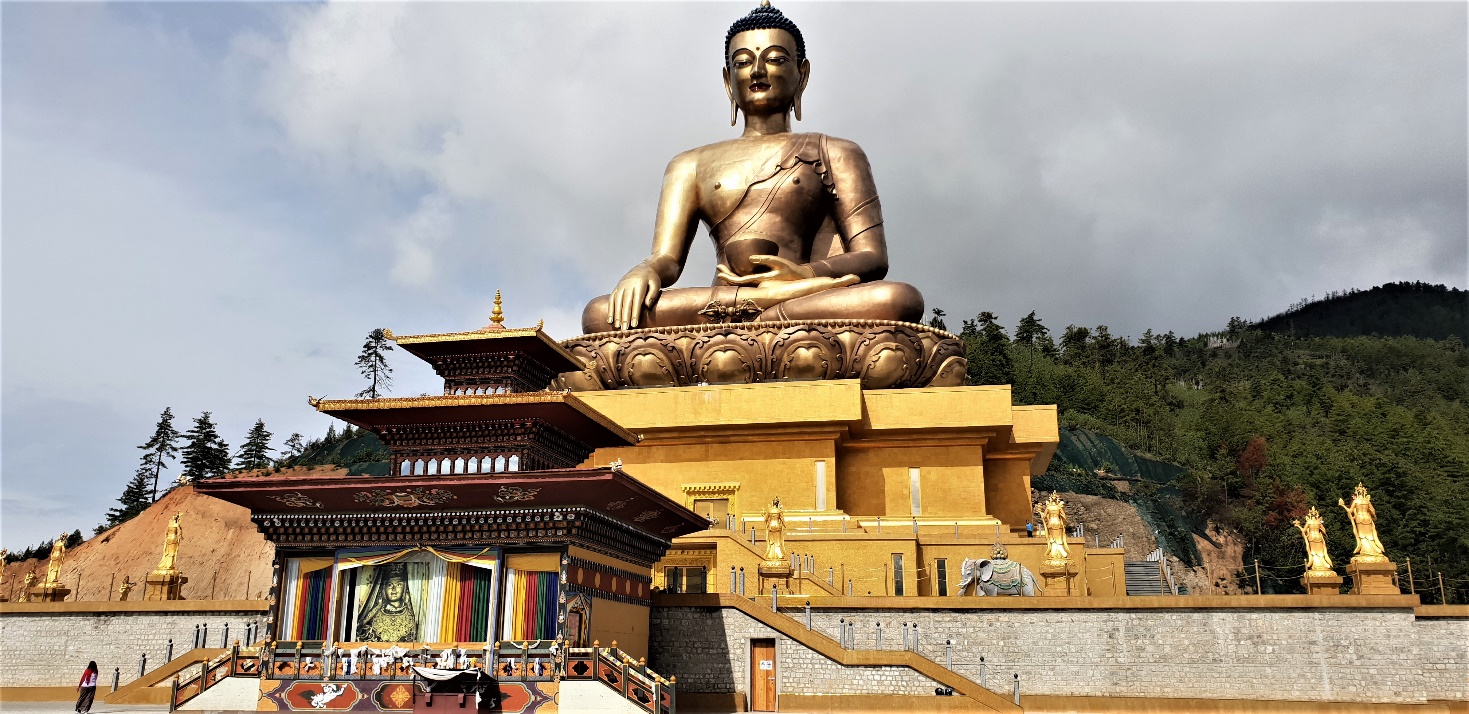Day 1: Arrive Paro
The flight to Paro is one of the most spectacular in entire Himalayas. Whether flying along the Himalayan range from Kathmandu or over the foothills from Kolkata, the journey offers fascinating views and an exciting descent into the Kingdom. Bhutan’s first gift to you as you disembark from the aircraft will be cool, clean fresh mountain air. After immigration formalities and baggage collection, you will be met by our representative & transfer to hotel for check-in.
Later in the day after checking into hotel, proceed to visit Ta Dzong, originally built as Watchtower, which now houses National Museum. The extensive collection includes antique thangkha paintings, textiles, weapons &armour, household objects and a rich assortment of natural and historic artifacts.
Then walk down the trail to visit RinpungDzong, meaning (“fortress of the heap of jewels”), which has a long and fascinating history. Along the wooden galleries lining the inner courtyard are fine wall paintings illustrating Buddhist lore such as four friends, the old man of long life, the wheel of life, scenes from the life of Milarepa, Mount. Sumeru and other cosmic Mandala.
Overnight at the hotel in Paro
Day 2 In Paro
After breakfast, full day enjoy the “Paro Tshechu Festival” at Rinpung Dzong.
On this day we witness the many ceremonies which take place in the intense program of the festival. During the “Tshechu” locals wearing colorful traditional costumes and unique jewelry. It will be interesting to observe how this important religious event is an opportunity for aggregation: local communities live the party as a great time to find myself.
Overnight at the hotel in Paro
Day 3 In Paro
After breakfast excursion to Taktshang Monastery (approx. 5 hours walk): It is one of the most famous of Bhutan’s monasteries, perched on the side of a cliff 900m above the Paro valley floor. It is said that Guru Rinpoche arrived here on the back of a tigress and meditated at this monastery and hence it is called ‘Tiger’s Nest’. This site has been recognised as a most sacred place and visited by ShabdrungNgawangNamgyal in 1646 and now visited by all Bhutanese at least once in their lifetime. On 19 April, 1998, a fire severely damaged the main structure of building but now this Bhutanese jewel has been restored to its original splendour.
On the way back to town stop at DrukgyelDzong, a ruined fortress where Bhutanese warriors fought Tibetan invaders centuries ago. The snowy dome of sacred Chomolhari, “mountain of goddess” can be seen in all her glory from the approach road to the Dzong.
Along the way, visit the 7th century KyichuLhakhang, one of the 108 temples built in the Himalayas by Tibetan King, Songtsen Gampo. The building of this temple marks the introduction of Buddhism in Bhutan.
Evening an exploratory walk around Main Street and market area.
Overnight at the hotel in Paro
Day 4 Paro – Punakha (120 Kms / 4½ Hrs Drive approx)
After breakfast, check out from the hotel and drive to Punakha, en-route visit SimtokhaDzong, the place of profound tantric teaching, this Dzong now houses a school for the study of the Dzongkha language and further cross Dochula pass (3O8O M). In Bhutan, the passes are marked by a large Bhutanese Chorten and prayer flag. Dochula pass offers the most spectacular view over the high peaks of the eastern Himalayas on a clear day.
On arrival at Punakha, check into the hotel and Afternoon visit Punakha Dzong or (Palace of Great Happiness), built at the junction of the Phochu and Mochu rivers in 1637 by ShabdrungNgawangNamgyal. This majestic Dzong served as both the religious and the administrative center of Bhutan in the past. It measures some 600 by 240 feet and has a six-story, gold-domed tower. Inside are courtyards and religious statuary that hint at the depth of history and spiritual tradition embodied here. Your guide will illuminate your understanding of this intricate culture that is exotic to us, though long established here.
Later in the day excursion to Chimi Lhakhang. The Chimi Lhakhang, situated on a hillock in the centre of the valley, also known as the temple of fertility. It is widely believed that couples who do not have children and wanting one, if they pray at this temple, they are usually blessed with a child very soon. The trail leads across rice fields to the tiny settlement of Pana, meaning ‘field’. A walk through the village near the temple will give you rare glimpses into the daily life and lifestyle of the villagers.
Overnight at the hotel in Punakha
Day 5 In Punakha
After breakfast, visit Sangchhen Dorji Lhuendrup Lhakhang Nunnery
Perched on a ridge amid pine trees and overlooking valleys of Punakha and Wangduephodrang, gleams the magnificent structures of Sangchhen Dorji Lhuendrup Lhakhang(Temple). The temple houses a 14-foot main bronze statue of Avalokiteshvara (Chenrigzig chagtong chentong). Other statues include those of Guru Padmasambawa, Gautama Buddha, Zhabdrung Ngawang Namgyel, Tsela Namsum, the 21 Taras and Tsepamay (Buddha of longevity). The Avalokiteshvara statue, one of the biggest in the country, was the handiwork of entirely local Bhutanese artisans. The temple complex also houses a permanent higher learning and meditation centre for nuns where, apart from religious trainings, it provides life skill training such as tailoring, embroidery, statue making and thangka painting.
Evening free for the self-exploration
Overnight at the hotel in Punakha
Day 6 Punakha – Gangtey (70 Kms / 03 Hrs Drive Approx)
After breakfast, check-out from the hotel & drive Gangtey (Phobjikha)
On arrival in Gantey; Check-into the hotel. The approach to Phobjikha valley is through a forest of oak and rhododendron. Phobjikha is one of the few glacial valleys in Bhutan and chosen home of black necked cranes, which migrate from the central Asiatic Plateau to escape its harsh winters.
Evening explore around on your own
Overnight at the hotel in Gangtey
Day 7 In Gangtey
After breakfast, explore Phobjikha valley for Black Neck Cranes and later visit to Gangtey Goempa, perched on a small hill that rises from the valley floor, the Gangtey Monastery is the only Nyingmapa monastery on the western side of the Black Mountain’s Gangtey valley and also the biggest Nyingmapa monastery in Bhutan. The Monastery is surrounded by a large village inhabited mainly by the families of the 140 Gomchens who take care of the Monastery. Gangtey was founded by Pema Trinley, the grand son of Pema Lingpa, the famous Nyingmapa saint of Bhutan. In 1613, Pema Trinley establish the monastery and became the first Gangtey Tulku. The religious traditions of Pema Lingpa still taught there. The second Tulku, Tenzin Legpa Dondrup (1645 to 1726), enhanced the size of Gangtey while keeping up good relations with Drukpas, and rebuilt the monastery in the form of a Dzong.
Rest of the day is at leisure
Overnight at the hotel in Gangtey
Day 8 Gangtey – Thimphu (150 Kms/ 05 Hrs Drive Approx.)
After breakfast; check out from the hotel and drive to Thimphu
On arrival in Thimphu; Check-into the hotel. The capital town of Bhutan and the centre of Government, religion and commerce, Thimphu is a unique city with unusual mixture of modern development alongside ancient traditions. With the population of about 90,000 it is perhaps still the world’s only capital city without a traffic light.
Later visit to Trashichhoedzong: This impressive fortress/monastery houses Secretariat building, the throne room of His Majesty, the King and various government offices. It is also the summer residence of Chief Abbot and central monk body.
Afterwards visit to Buddha Point (KuenselPhodrang). Located at a short drive from Thimphu city centre, visitors can get a good overview of the Thimphu valley from the Buddha point (KuenselPhodrang). You can pay your obeisance and offer prayers to the Buddha, the largest statue in the country and then walk around and take a glimpse of the valley.
Evening an exploratory walk around Thimphu Main Street and market area. Also visit the Local Crafts Bazaar, to browse through example of Bhutan’s fine traditional arts. Here you can buy hand-woven textiles, Thangkha paintings, masks, ceramics, slate and wood carvings, jewellery, interesting items made from local materials.
Overnight at the hotel in Thimphu
Day 9 In Thimphu
After breakfast, sightseeing in Thimphu valley including visit to the following: the National Library, housing an extensive collection of priceless Buddhist manuscripts; the Institute for Zorig Chusum (commonly known as the Painting School) where students undergo a 6-year training course in Bhutan’s 13 traditional arts and crafts. Later visit Textile Museum, which provides insight into Bhutan’s one of the most distinct art form.
After lunch visit Simply Bhutan, a living museum and studio encapsulating the cultural heritage of the Bhutanese people.
Further visit to Buddha Point (KuenselPhodrang). Located at a short drive from Thimphu city centre, visitors can get a good overview of the Thimphu valley from the Buddha point (KuenselPhodrang). You can pay your obeisance and offer prayers to the Buddha, the largest statue in the country and then walk around and take a glimpse of the valley.
King’s Memorial Chorten continuously circumambulated by people, murmuring mantras and spinning their prayer wheels. Construction of this landmark was the idea of Bhutan’s third king, His Majesty Jigme Dorji Wangchuk (“the father of modern Bhutan”) who has wished to erect monument to world peace and prosperity. Completed in 1974 after his untimely death, it serves both as a memorial to the Late King and as a monument to peace.
Later visit to Trashichhoedzong: This impressive fortress/monastery houses Secretariat building, the throne room of His Majesty, the King and various government offices. It is also the summer residence of Chief Abbot and central monk body.
Overnight at the hotel in Thimphu.
Day 10 Thimphu – Paro (55 Kms / 1 ½ Hrs Drive Approx.)
After breakfast at the hotel, drive to Paro airport for flight to your onward destination. Our representative will help you with exit formalities and then bid you farewell.







Reviews
There are no reviews yet.